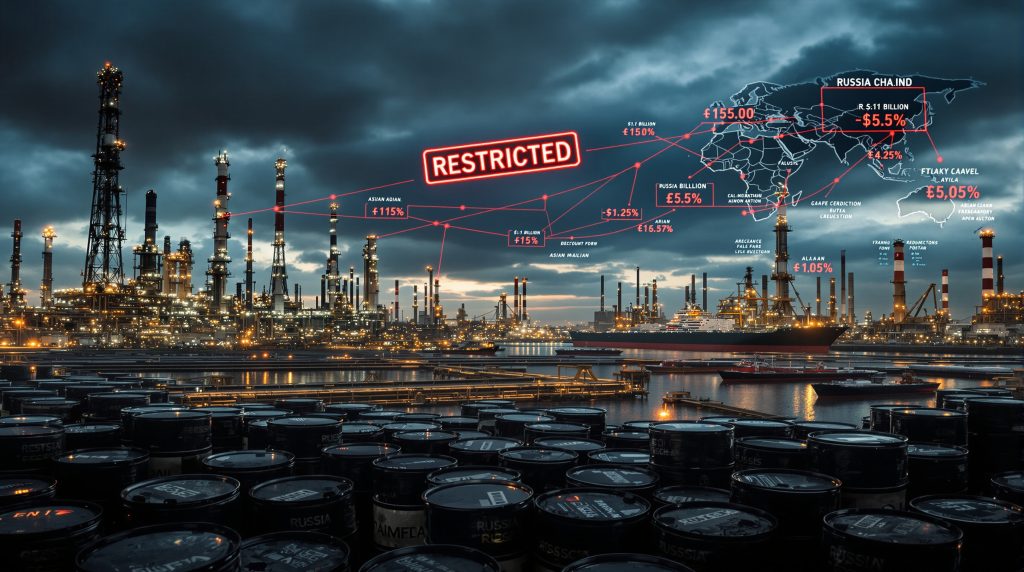Understanding the Latest Sanctions Framework
The comprehensive energy restrictions implemented through recent U.S. sanctions represent a fundamental shift in Washington's approach to constraining Russian petroleum exports. The U.S. sanctions impact on Russian oil production has created an unprecedented regulatory framework that encompasses both state-controlled and privately-owned production entities across Russia's energy sector. Furthermore, these measures extend far beyond previous targeted actions through their comprehensive scope and enforcement mechanisms.
What Makes These Energy Restrictions Different from Previous Measures?
The current sanctions architecture differs significantly from earlier approaches through its comprehensive scope and enforcement mechanisms. Unlike previous measures that targeted specific individuals or narrow sectors, these restrictions create a unified framework affecting major segments of Russian crude production and export operations. Additionally, the US oil production decline in domestic markets adds complexity to global supply dynamics.
The regulatory structure encompasses multiple enforcement tools, including Specially Designated Nationals (SDN) classifications that prohibit U.S. persons from engaging in transactions with listed entities while blocking assets held in U.S. jurisdiction. Under the authority of the International Emergency Economic Powers Act (IEEPA) and the Countering America's Adversaries Through Sanctions Act (CAATSA), these designations carry global reach due to U.S. dollar settlement systems and extraterritorial enforcement capabilities.
Key Components of the Sanctions Architecture
The framework operates through several interconnected mechanisms:
• SDN designations that freeze assets and prohibit transactions with major Russian energy producers
• Secondary sanctions authority under CAATSA Section 235, enabling penalties against foreign entities conducting significant transactions with sanctioned Russian sectors
• Coordinated implementation across multiple jurisdictions, including synchronized announcements between U.S., UK, and EU authorities
• Asset freezes and comprehensive transaction prohibitions affecting American entities and their global operations
Secondary sanctions represent a particularly significant enforcement tool, as they extend U.S. regulatory reach to foreign companies and financial institutions. However, historical enforcement has been selective to avoid overreaching consequences that could disrupt global financial systems or harm allied nations' economic interests.
Which Russian Oil Giants Face the Heaviest Impact?
The targeting of Russia's largest petroleum producers creates immediate operational challenges across extensive global value chains. These designations affect companies responsible for substantial portions of Russian crude output, fundamentally altering international partnership structures and export arrangements. Moreover, this connects directly with broader concerns about OPEC production impact on global markets.
Rosneft: State-Controlled Production Under Pressure
As Russia's dominant petroleum producer, Rosneft PJSC faces comprehensive restrictions that immediately complicate international operations. The company, majority-owned by the Russian government with approximately 50% direct state ownership plus additional stakes through state entities, represents a core component of Moscow's energy export strategy.
Rosneft's production capacity of approximately 2.1 million barrels per day makes it a critical revenue generator for the Russian state budget. The company contributes to oil and gas taxes that historically constitute 25-35% of federal government revenues. The company's extensive operations span upstream production, refining, and international trading across multiple continents.
The designation creates systematic challenges for maintaining established export relationships, particularly with buyers in Asian markets including China and India. These disruptions affect downstream operations across multiple jurisdictions where Rosneft maintains partnerships or subsidiary operations.
Lukoil: Private Sector Adaptation Strategies
Despite its private ownership structure, Lukoil PJSC confronts similar regulatory obstacles in maintaining international operations. As Russia's second-largest crude producer with daily output of approximately 1.0 million barrels per day, the company's designation affects its diversified portfolio spanning upstream, downstream, and petrochemical segments.
Lukoil's global footprint includes historically significant operations across Europe, Asia, and Africa. The company maintains notable refineries in Bulgaria, Romania, and Peru, plus production assets in the Caspian Sea region. The company's publicly traded status on multiple exchanges, including historical listings on Moscow Exchange, reflects its more complex ownership structure compared to state-controlled entities.
The sanctions create particular challenges for Lukoil's international partnerships, as foreign companies must evaluate compliance requirements when continuing business relationships. This affects not only direct crude sales but also joint ventures, technology partnerships, and financial arrangements across the company's global operations.
How Are Global Markets Responding to Supply Chain Disruptions?
International crude markets demonstrate varied responses to the expanded sanctions framework, with buyers implementing different risk assessment strategies while evaluating compliance requirements and alternative supply sources. Consequently, oil price movements reflect this increased uncertainty in global markets.
Asian Buyer Behavior Shifts
Major Chinese state enterprises have adopted cautious approaches to Russian crude purchases, temporarily suspending seaborne deliveries while maintaining pipeline flows. Pipeline deliveries through infrastructure like the Eastern Siberia-Pacific Ocean (ESPO) system continue providing steady supply volumes. Land-based routes face fewer direct enforcement challenges than maritime shipments.
The distinction between pipeline and seaborne deliveries reflects practical enforcement limitations. Pipeline infrastructure operates under long-term contracts and involves fewer intermediate financial transactions susceptible to sanctions compliance screening.
| Importing Region | Historical Import Levels | Current Adaptation | Alternative Supply Sources |
|---|---|---|---|
| China | Major supplier relationship | Pipeline flows maintained | Middle East, Americas expansion |
| India | Significant post-2022 volumes | Reduced seaborne purchases | Gulf states, African crude |
| Turkey | Moderate import levels | Compliance review ongoing | Iraq, Kazakhstan alternatives |
Chinese independent refiners, known as "teapots," may demonstrate greater willingness to resume Russian crude purchases compared to state-owned enterprises. These smaller operators typically show higher risk tolerance and greater operational flexibility in navigating sanctions compliance challenges.
European Energy Security Considerations
European markets maintain complex relationships with Russian energy despite official policy objectives of reducing dependence. While EU nations have largely eliminated direct Russian crude imports following previous sanctions rounds, refined product flows continue through intricate trading arrangements involving third-party intermediaries.
These indirect channels highlight enforcement complexity in downstream sectors. Russian refined products including diesel, gasoline, and fuel oil reach European markets through intermediaries in third countries. Such arrangements demonstrate the practical challenges of completely severing energy trade relationships in integrated global markets.
What Revenue Impacts Are Russian Producers Experiencing?
The financial pressure on Russian energy revenues reflects both reduced export volumes and substantial price discounts that Russian crude faces in international markets. These revenue impacts directly affect government budget planning and state-owned enterprise financial performance. Additionally, the broader US‑China trade impact influences global energy demand patterns.
Export Revenue Decline Analysis
Russian crude now trades at discounts of $15-25 per barrel compared to Brent crude benchmarks. These discounts significantly expand beyond normal quality and transportation differentials. These larger discounts reflect increased market risk premiums associated with sanctions compliance concerns and reduced buyer competition.
The revenue impact extends beyond price discounts to include reduced total export volumes as some buyers suspend purchases pending compliance reviews. Oil and gas taxes historically comprise approximately 25% of Russian government revenue. This makes energy export performance critical for state budget sustainability.
Lower energy revenues force budget prioritisation decisions, as reduced receipts must accommodate continued military expenditures alongside domestic economic needs. The Russian government's reliance on energy taxes creates direct linkages between sanctions effectiveness and fiscal pressures on state spending programmes.
Ruble Exchange Rate Implications
Reduced energy export revenues affect currency strength and domestic inflation patterns. Fewer dollar-denominated receipts limit foreign exchange availability. Currency weakness amplifies the domestic cost of imports, including technology and equipment needed for energy sector operations.
The budget deficit implications extend beyond immediate revenue shortfalls to include debt service capabilities and long-term fiscal sustainability. Sustained revenue reductions may require difficult choices between military spending, social programmes, and infrastructure investments needed for economic development.
Are Russian Companies Finding Effective Workarounds?
Russian energy operators demonstrate significant adaptability in developing alternative export arrangements. They utilise new shipping networks and intermediary structures to maintain market access despite sanctions restrictions. The International Energy Agency has highlighted these evolving patterns in global markets.
Shadow Fleet Operations Expansion
New shipping entities have emerged to handle substantial crude and refined product export volumes. These operations utilise vessel networks not currently subject to sanctions designations. These operations reflect historical Russian expertise in sanctions circumvention, drawing on experience from previous restrictions implemented since 2014.
The characteristics of these alternative shipping arrangements typically include:
• Vessels flagged to countries with minimal regulatory oversight
• Older ships with limited transparency regarding beneficial ownership
• Complex corporate structures designed to obscure ultimate control
• Insurance and financing arrangements outside traditional Western systems
Shadow fleet vessels often involve increased operational costs through higher insurance premiums, longer transportation routes, and price discounts. These additional costs reduce net revenues but maintain market access for Russian exporters.
Historical Sanctions Evasion Success
Previous designations of companies like Surgutneftegaz and Gazprom Neft provide precedent for adaptation strategies. Both entities maintained export operations through intermediary arrangements without triggering widespread secondary sanctions enforcement against their partners.
This historical experience suggests Russian companies possess institutional knowledge and operational flexibility for sanctions circumvention. They utilise trading networks and financial arrangements that complicate enforcement efforts by international authorities.
How Effective Is International Enforcement Coordination?
The synchronised implementation across multiple jurisdictions creates more comprehensive coverage than previous unilateral measures. However, enforcement consistency remains challenging across different regulatory frameworks and legal systems. The U.S. Treasury Department has outlined specific enforcement priorities for these sanctions.
Multi-Jurisdictional Approach Assessment
Coordination between U.S., UK, and EU authorities represents significant improvement over previous approaches. However, each jurisdiction maintains separate legal frameworks with different definitional standards and exemption procedures.
| Enforcement Authority | Primary Legal Tools | Jurisdictional Scope | Secondary Sanctions |
|---|---|---|---|
| United States | OFAC SDN designations | Global dollar transactions | CAATSA authority |
| United Kingdom | Sanctions Act 2020 | UK persons and assets | Limited extraterritorial |
| European Union | Council regulations | EU member states | Coordinated approach |
The United States maintains the broadest enforcement reach through dollar-based transaction monitoring and extraterritorial application of sanctions laws. However, effectiveness depends on sustained coordination and consistent enforcement priorities among allied governments.
Enforcement Limitations and Challenges
Secondary sanctions authority under CAATSA provides significant theoretical deterrent effect. However, practical application requires careful calibration to avoid disrupting allied relationships or essential global commerce flows. Historical enforcement has been selective, focusing on the most significant violations while allowing smaller transactions to continue.
The complexity of global energy markets creates enforcement challenges. Crude oil moves through multiple intermediaries, financial institutions, and transportation networks across different legal jurisdictions. This complexity provides opportunities for sanctions evasion while complicating comprehensive enforcement efforts.
What Are the Long-Term Production Implications?
Sustained sanctions pressure may create structural changes in Russian production capabilities through reduced investment, limited technology access, and altered global market relationships. These changes may persist beyond current geopolitical tensions.
Investment and Technology Access Constraints
Western service companies face compliance requirements that limit participation in Russian energy projects. This potentially affects field development and technology transfer. These restrictions may impact production efficiency and future capacity expansion across Russian oil fields.
Advanced extraction technologies, particularly for challenging reservoirs and enhanced oil recovery, often rely on Western equipment and expertise. Sanctions restrictions may force Russian companies to develop domestic alternatives or seek technology partnerships with non-Western suppliers. This potentially comes at higher costs or with reduced effectiveness.
Production Capacity Maintenance Challenges
Russia's current production levels of approximately 9.3 million barrels per day face potential decline without continued investment in field maintenance and development. Older fields require ongoing investment to maintain output levels. Meanwhile, new field development becomes more challenging without access to international financing and technology.
The maintenance of production infrastructure, including pipelines, refineries, and export terminals, depends on equipment and spare parts. These may become more difficult to obtain under sanctions restrictions. These operational challenges could create cumulative effects on production capability over time.
Which Global Energy Markets Face the Greatest Disruption?
Different regional markets experience varying degrees of disruption based on their historical relationships with Russian suppliers and availability of alternative sources. In particular, this affects energy exports challenges for countries seeking to fill supply gaps.
Asian Refining Sector Adjustments
Independent Chinese refiners may demonstrate greater flexibility in resuming Russian crude purchases compared to state-owned enterprises. These smaller operators typically accept higher compliance risks in exchange for discounted crude prices. This buyer segment could provide continuing market access for Russian exports despite official restrictions.
Asian refiners face complex decisions balancing cost advantages of discounted Russian crude against potential sanctions risks and reputational concerns. The availability of alternative suppliers from the Middle East, Americas, and Africa affects this calculation. Tighter global supplies increase the value of Russian discount pricing.
Indian Market Recalibration
Indian refiners, which became significant Russian crude consumers following previous sanctions rounds, now evaluate alternative supply sources while assessing secondary sanctions risks. This market shift affects global crude trading patterns, as Indian demand redirects toward Gulf states and African producers.
The Indian refining sector's adaptation demonstrates how sanctions reshape global energy flows. Countries previously outside traditional supply relationships develop new commercial arrangements to replace restricted Russian volumes.
European Refined Product Dependencies
Despite crude import restrictions, European markets continue receiving Russian refined products through third-party trading arrangements. This highlights the complexity of completely severing energy trade relationships. These indirect flows affect pricing dynamics and supply security across European refined product markets.
The persistence of these trading relationships demonstrates practical limitations of sanctions enforcement in complex downstream markets. Product origin becomes more difficult to track through multiple intermediary transactions.
How Are Energy Prices Responding to Supply Uncertainty?
Crude oil pricing dynamics reflect both immediate supply concerns and longer-term uncertainty about Russian market participation. This creates volatility and regional price differentials across global markets. The U.S. sanctions impact on Russian oil production continues to influence these pricing patterns significantly.
Russian Crude Discount Expansion
The widening of Russian crude discounts to $15-25 per barrel below Brent benchmarks creates significant arbitrage opportunities for buyers willing to accept compliance risks. These discounts exceed normal quality and transportation differentials, reflecting substantial sanctions risk premiums.
The expanded discount structure affects global pricing patterns. Buyers compare discounted Russian crude against alternative suppliers charging market prices. This dynamic influences both spot market transactions and longer-term supply contract negotiations.
Regional Price Variations and Market Segmentation
Different regional markets demonstrate varying price responses based on their access to alternative supplies and risk tolerance for Russian crude purchases. Asian markets with greater supplier diversification options may show less price volatility than regions with limited alternative access.
Strategic petroleum reserve releases by consuming nations help moderate price volatility while markets adjust to new supply patterns. However, the effectiveness of these interventions depends on the scale and duration of Russian supply disruptions.
Price Discovery Challenges in Sanctions Environment
Traditional price discovery mechanisms face complications when major suppliers operate under sanctions restrictions. Transaction volumes and market participation patterns change significantly. This affects both spot pricing and longer-term contract benchmarking across international crude markets.
What Does This Mean for Global Energy Security?
The reshaping of Russian oil production through sanctions creates both immediate supply chain adjustments and longer-term structural changes in global energy relationships. These changes extend beyond current geopolitical tensions.
Supply Chain Resilience Testing
Current sanctions provide a comprehensive test of global energy system adaptability. They reveal both vulnerabilities in existing supply chains and alternative capabilities that can provide market stability. The responses of different market participants demonstrate varying degrees of resilience and flexibility.
Strategic petroleum reserves serve important stabilisation functions during supply disruptions. However, their effectiveness depends on the scale and duration of market disruptions. The coordination of reserve releases among consuming nations enhances their market impact during crisis periods.
Geopolitical Energy Realignment
The U.S. sanctions impact on Russian oil production accelerates existing trends toward regional energy bloc development. Asian consumers potentially develop stronger relationships with Middle Eastern and American producers. European markets simultaneously work to diversify away from historical Russian energy dependence.
This realignment process creates both opportunities and challenges for different producing regions. Traditional supply relationships undergo fundamental restructuring. The speed and effectiveness of this transition affects global energy security and price stability.
Long-Term Market Structure Evolution
Sustained sanctions pressure may permanently alter global crude trading patterns. This could potentially reduce Russian market share even if restrictions are eventually lifted. These structural shifts could reshape international energy relationships for decades, affecting everything from infrastructure investments to strategic partnerships.
The development of alternative supply chains and trading relationships during the sanctions period may prove durable even after geopolitical tensions resolve. Buyers and suppliers establish new commercial patterns and risk management strategies.
Investment Implications: Energy market participants must evaluate both immediate supply disruption risks and longer-term structural changes in global trading patterns when making strategic planning decisions. The effectiveness of sanctions circumvention strategies and enforcement coordination will significantly influence market evolution over the coming years.
Disclaimer: This analysis is based on publicly available information and market observations. Energy market conditions, sanctions enforcement, and geopolitical developments can change rapidly, affecting the accuracy of forward-looking assessments. Readers should consult current official sources and professional advisors when making investment or operational decisions.
Are You Seeking Opportunities in Energy Market Volatility?
Discovery Alert's proprietary Discovery IQ model delivers real-time alerts on significant ASX mineral discoveries, helping subscribers identify actionable opportunities in volatile markets like today's energy sector. With global supply chains reshaping and commodity prices fluctuating, Discovery Alert empowers both short-term traders and long-term investors to capitalise on market shifts ahead of the broader market.




